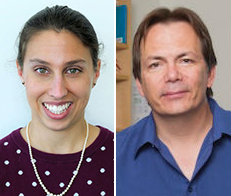
Study links autism to new set of rare gene variants
The effects of these newly identified genes are unknown, but some are associated with protein networks known to play a role in autism.Media Contact: Brian Donohue - 206.543.7856, bdonohue@uw.edu
Researchers today report the finding of a new set of ultra-rare gene variants that increase a child’s risk of developing autism.
“These ultra-rare variants involve a set of genes that have not been associated with autism before,” said Amy B. Wilfert, a senior research fellow in the Department of Genome Sciences at the University of Washington School of Medicine. She was the lead author of the report published July 26 in the journal Nature Genetics. Evan Eichler, UW professor of genome sciences, led the team that conducted the study.
The findings should help researchers better understand how the genetic risk of developing autism is inherited and how mutations in these variants might contribute to the disorder.

Autism, or autism spectrum disorder (ASD), affects about 1 in 59 children in the United States. The exact cause is unknown, but certain genes with deleterious mutation are known to increase the risk of developing the disorder.
To date, most research has focused on genes with mutations not found in the parents’ genomes but which originate in the sperm, the egg, or very early in the development of the fertilized egg. Such “de novo” variants have been shown to greatly increase a child’s risk of developing ASD, but account for a relatively small percentage of cases.
To better understand how children might inherit mutations in genes from a parent that put them at risk of developing ASD, the Seattle researchers and their collaborators looked for variants in genes so rare that they appeared in only one parent in a study group involving thousands of families. Such variants are called ultra-rare or private variants.
To find these ultra-rare variants, the researchers examined the genome sequences of nearly 3,500 families that had at least one child with ASD. They limited their search to changes in the genes that would likely disable the gene, called likely-gene disruptive (LGD) variants. They then repeated the analysis in a larger dataset of nearly 6,000 families. Overall, they analyzed nearly 35,000 genomes.
In the end, they identified 163 candidate genes with private LGD variants that collectively increase the risk of ASD. These genes had not been previously identified as ASD-risk genes by studies of de novo variants. The researchers estimate these mutations in these genes may account for as much as 4.5% of autism cases. That’s on par with the percentage ascribed to the more intensely studied de novo variants.
Inheriting one or more of these variants is not enough to cause ASD as none of the parents who carried the variants had ASD, the researchers found. Some additional factors, either genetic or environmental, must therefore have to be present for the child to go on to develop ASD. This finding supports the theory that changes in multiple genes must be present for a child to develop ASD, known as the “multi-hit” model. “Our study suggests that one inherited mutation is not enough,” said Wilfert. “You need at least one other mutation to push a child over the threshold required to be diagnosed with autism.”
One reason why these variants are so rare is that they appear to be relatively short-lived, persisting in a family for only a few generations, perhaps because those children that inherit them are less likely to go on to have children of their own, the researchers said.
Just how these ultra-rare variants increase a child’s risk of ASD is unknown, Wilfert said, but many of the genes are involved in protein networks that play a role in biochemical pathways that have been previously linked to the development of ASD.
“The availability of large whole genome and exome datasets made it possible to identify such rare variants. Without the sequencing efforts by our collaborators at the Centers for Common Disease Genomics, and the study coordination efforts from Simons Foundation this study would have been impossible," she said. "Our findings won’t be brought into the clinic tomorrow,” Wilfert said, “but they do give researchers new areas to focus on and may lead to clinically relevant knowledge in the future.”
Study collaborators included researchers from the Allen Institute for Brain Science in Seattle, the New York Genome Center in New York, and the Center for Medical Genetic & Hunan Key Laboratory of Medical Genetics, Central South University, in Changsha, China.
This work was supported in part by grants from the National Institutes of Health (R01 MH101221, R01 MH100047, K99 MH117165, K99 HG011041, UM1 HG008901); the National Human Genome Research Institute; National Heart, Lung, and Blood Institute; the Genome Sequencing Program Coordinating Center (U24 HG008956); National Institute of Mental Health via Autism Speaks (1U24MH081810); the Howard Hughes Medical Institute; and the Simons Foundation.
For details about UW Medicine, please visit https://uwmedicine.org/about.
